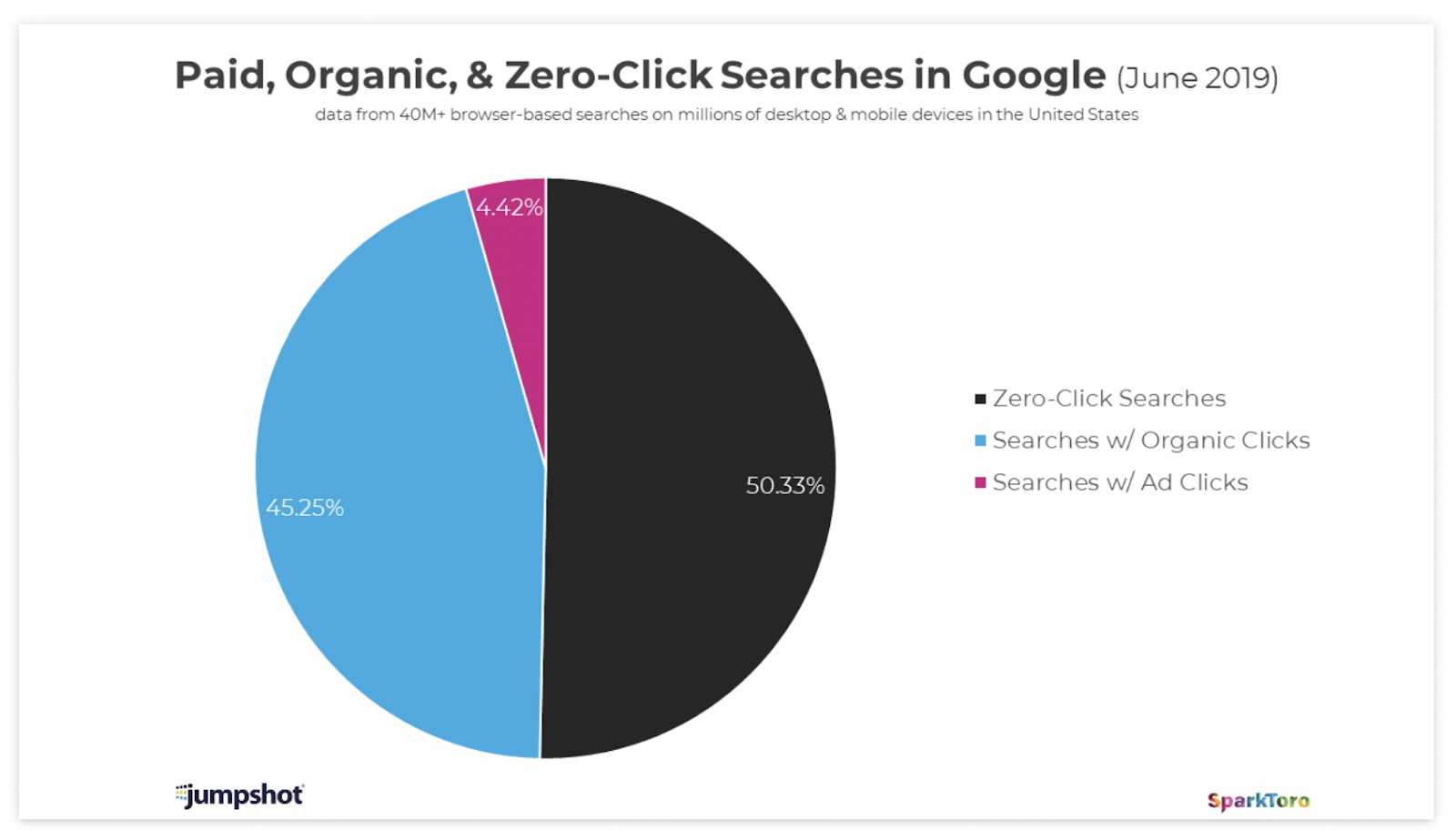No two SERPs are the same
Before we dive into the guts of SERPs (search engine results pages), and tell you how you to get your page in front of thousands of eyeballs, know this:
Every search engine results page shows different results based on the query entered into the search bar.
If a query is informational, the anatomy of the SERP will look different from a query that is transactional or navigational.
This functionality is amazing because it caters to each user.
This is how Google (the dominant search engine on the market today), rose to prominence over all the other search engines; Google focused on positive user experience.
Want to know what Google does behind the scenes to rank pages? We’ll answer that.
We’ll also talk about
- the history of search engines
- the global SERP players
- the anatomy of a SERP page
- the difference between the paid parts and the organic parts
- how your SEO work gets you on page one (the only SERP page people give a dang about)
- Google's algorithm—how it always changes and how, frustrating as that can be for marketers, it's a good thing.
Get brand new SEO strategies straight to your inbox every week. 23,739 people already are!Sign Me Up
A brief history of the search engine
Can we pause for a miraculous moment to appreciate that Google wasn't even around 25 years ago?
Search engines weren't even invented until 1991.
Some of us struggled through the early days of Lycos, Excite, and Altavista before Yahoo! overtook the search engine landscape. Then Yahoo! bit the dust (not entirely) when Google came out of nowhere to dominate the search engine world to this day.
That’s the Coles Notes version.
If you love timelines and reading about how things were born and evolved, then read on. If not, jump to What is SERP and get on with the nuts and bolts.
For the history buffs:
Hypertext
The idea of hypertext (links) first appeared on the heels of WWII (1945) when scientists put forward the idea of linking bodies of knowledge together and sharing that knowledge across a global network. That concept gained traction from Harvard in the 1960s when Gerald Stalton's team came up with the SMART system (Salton’s Magic Automatic Retriever of Text).
The ARPAnet
In 1975, the US Dept. of Defense built upon early systems, creating the ARPAnet, a computer network that used a TCP/IP protocol. It was the technical foundation of the internet.
Archie
The first few hundred websites on the internet were created by colleges and worked via FTP servers (file transfer protocol). In 1990, a McGill university student, Alan Emtage, in Montreal, Canada, came up with a way to organize those college websites by putting them in a database and adding search functionality.
It was a rudimentary search engine.
Emtage named it Archie, a play on the word “archives." Soon, other search engines emerged in the United States (Veronica and Jughead), playing off Archie comics.
The rest happened quickly.
The World Wide Web (WWW)
In 1991, Tim Berners-Lee smashed together three concepts: hypertext, TCP/IP protocol, and DNS (domain name system) to create what he called the World Wide Web (WWW).
He put up the very first web page on the web (and it still exists today) where he defined his new creation:
The WorldWideWeb (W3) is a wide-area hypermedia information retrieval initiative aiming to give universal access to a large universe of documents.
And there it was.
The realization of a concept put forward by scientists 46 years earlier; a way to connect and grow information around the world.
Bots
It wasn't long before the burgeoning number of websites needed software to track and index what those websites were about.
Bots were born (also known as spiders).
These bots followed calculated instructions, crawling the internet, following links, indexing pages, and tagging their purpose. According to their algorithm, they continually updated the master catalog.
Modern search engines
Having a master catalog was essential, but searchers needed an interface to search that catalog on the web. The modern search engine results page was born.
Though many early days search engines popped up, Yahoo! stole the stage, launching in 1994 with its iconic yodel marketing. Google came along shortly afterward in 1997, followed by MSN Search in 1998, and Baidu in China in 2000 (still used as the main search engine in China today).
Google rapidly grew in popularity because it did a lot of things right, the most important of which was its core focus on user experience (UX).
For example, Google
- scaled its powerful algorithm
- introduced updates that minimized spam
- provided choice to users as they typed their queries (autocomplete)
- created Google Ads (Adwords)
- provided instant previews, and
- introduced the Google toolbar (that made it possible to search Google from any webpage).
Yahoo!'s popularity declined from 2000 onward after a series of bad horizontal investments. In 2009, MSN Search merged with Yahoo!, renaming its search engine “Bing.”
Bing is the only search engine today that makes a big enough ballyhoo to be bothersome to Google.
Today, Bing only has 4% of the global search engine market (including Yahoo!). Its main user base is the United States, where Bing (including Yahoo!) carves out 8%. That figure sounds piddly compared to Google, but piddly equates to billions of searches every month.
American marketers continue to advertise on Bing because it reaches a particular (wealthy) segment of the US population that, when combined with its cheaper advertising rates, makes Bing better than Google some of the time.
The shortlist of other search engines used around the world today share less than 3% of the search engine market and are specific to regions (except for Ecosia, the little eco-friendly search engine that turns searching for stuff into an environmental affair).
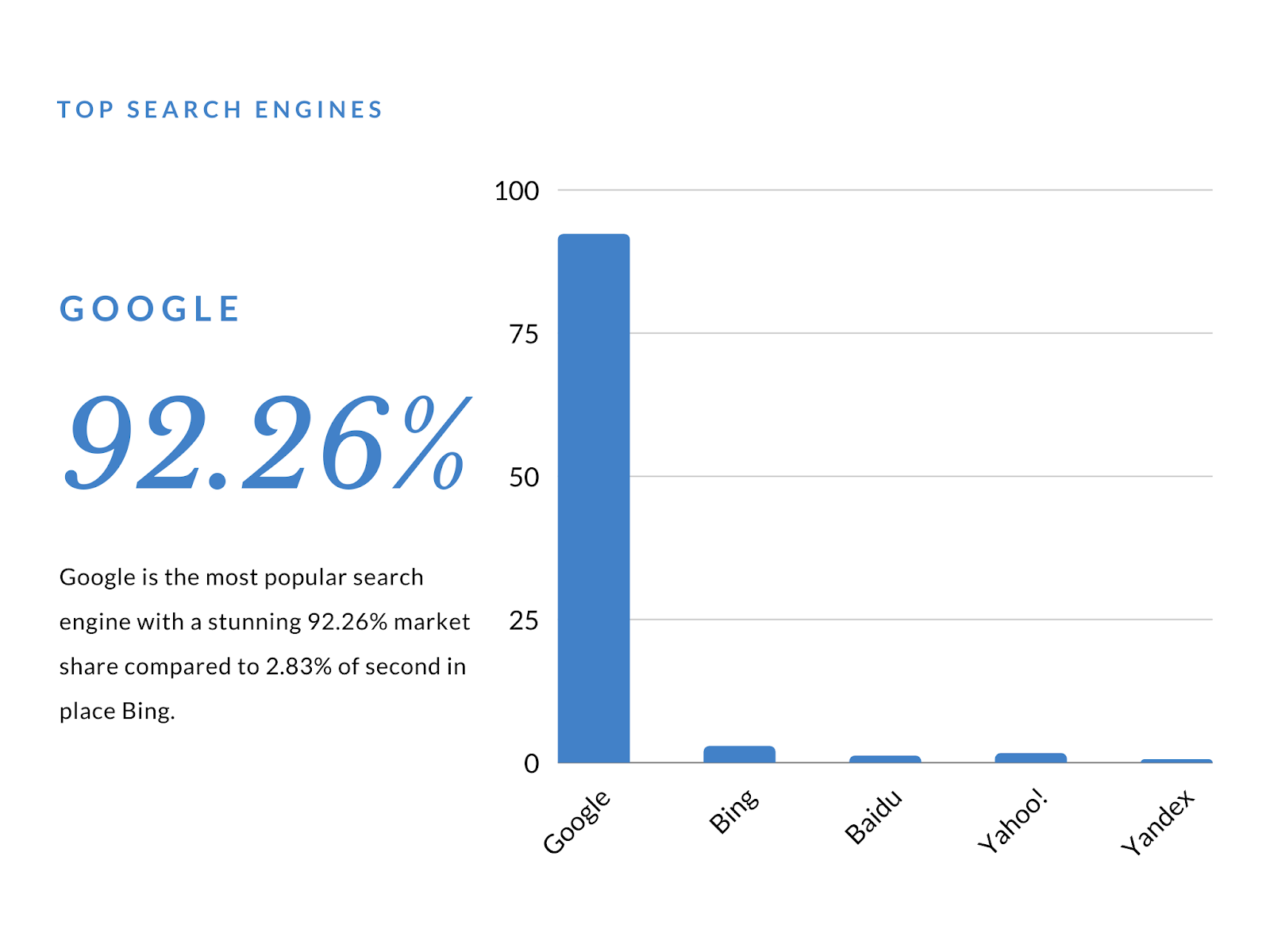
Top 7 global search engines, ranked by popularity.
- Google (92%)
- Microsoft Bing (mainly used in the USA) 2.83%
- Yahoo (powered by Bing) 1.53%
- Baidu (mainly used in China) 1.29%
- Yandex (mainly used in Europe) 0.79%
- DuckDuckGo (focuses on user privacy 0.60%)
- Ecosia (powered by Bing but uses its own algorithm, every search removes 1kg of CO2 because Ecosia invests 80% of its profits into worldwide reforestation) 0.13%
Will any of these small search engines be around in 10 years?
Who knows, but I certainly hope Ecosia gains popularity. 😊 Competition makes the world go ‘round and an eco-friendly search engine protects that world.
That’s it for history.
Now you know how SERPs came to be SERPs as we know them in a 76-year nutshell. For the rest of this post, we will focus on the search engine giant, Google.
What is SERP?
Short for Search Engine Results Page, a SERP is a page that displays a list of links (URLs) that have the best chance of answering a search query.
URLs are ranked in order of relevance, and marketers aim to "rank zero," a position that appears at the top of the page in special (rich) page elements like featured snippets, answer boxes, and knowledge panels.
SERPs have evolved from basic databases into complex pages that serve up results based on the type of query.
What displays on a SERP page changes with every query, but there are always three main parts:
- Paid results
- SERP featured sections
- Organic results
How valuable are each of these parts?
Ahrefs (using data from SparkToro) suggests that SERP Features (zero-click searches) and organic listings get roughly half the clicks each, with paid ads winning clicks less than 5% of the time.
Righto. Good to know.
Now let’s talk about the dynamic nature of SERPs.
Within these three categories, SERPs look dramatically different from search to search.
We’ll cover all of the possible places your snippet (title + meta description + keyword + URL) could appear in the SERP schematics below.
The anatomy of a search engine results page
Search engine results pages change in structure based on what a user types into the Google search bar.
For example, if you ask about:
- A product: you will see Shopping ads
- A direct question: you will likely get an Answer box (a rich feature).
- An address: a Google Map will appear
- What something looks like: you’ll likely see an image pack (a grid of thumbnail images)
- Anything that ends with "near me": you'll see a local pack
We’ll tackle the SERP page from top to bottom, starting with the Google search tabs.
Google search results tabs
Below the search bar, you’ll see five tabs, a “More” menu, and an option called “Tools.”
Search bar options:
- All
- Shopping
- Images
- News
- Videos
Let’s perform a search about everyone’s favorite camping food: Spam (amiright? 🤢), and see what we get:

Tools tab
If you click the Tools option at the far right, the number of results and the time it took to pull up those results are replaced with a set of filters that change according to the search query.
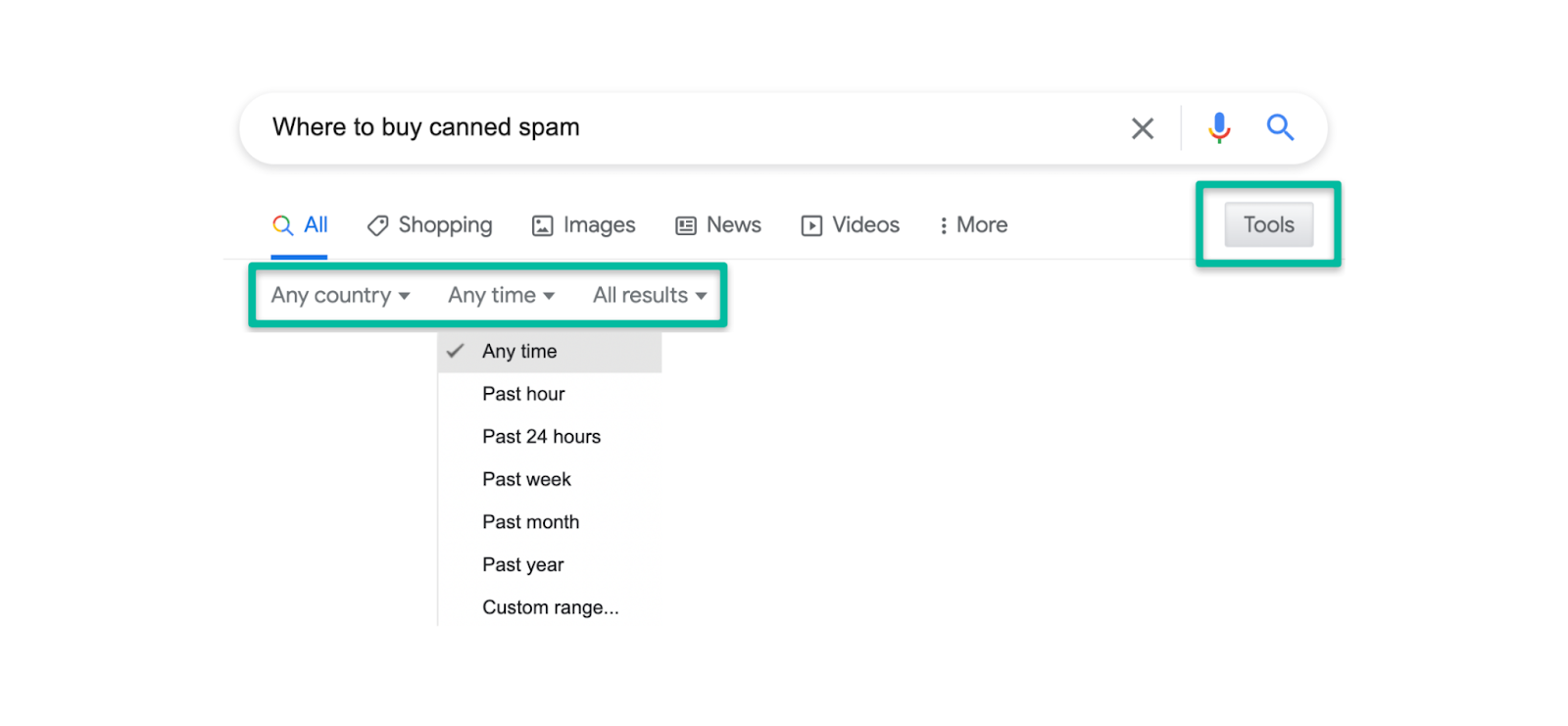
Choose between All results (which are corrected, personalized, and related results) or Verbatim results (which exactly match your search term).
All tab
The All tab shows the default SERP page, which contains the customized SERP features Google thinks will best answer the query. This is a combo of ads, organic results, and rich results like a featured snippet or an image pack etc.
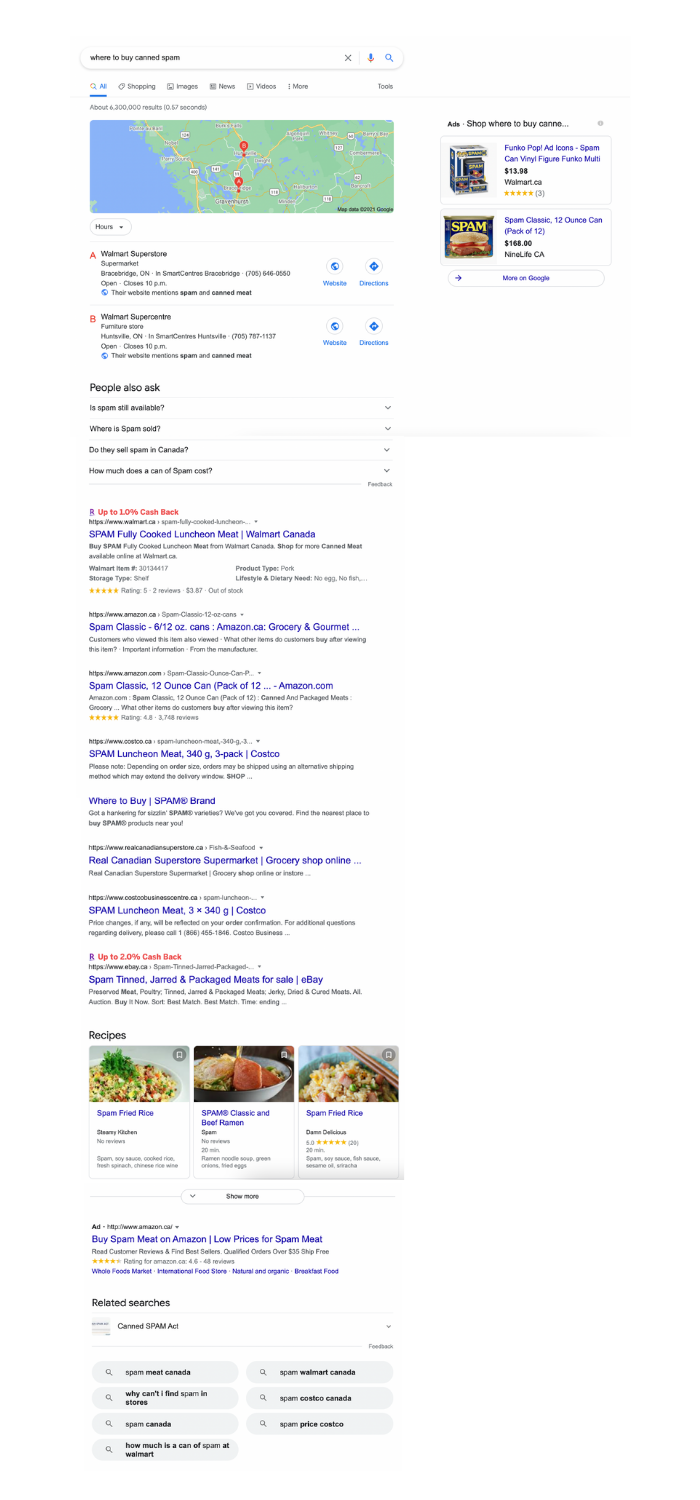
All brings up a map of nearby Spam sellers, ads, People also ask, a list of organic results, a recipe pack, another ad, and related searches like the Canned SPAM act (because Spam needs its own act?) 😳
Clicking on any of the other tabs under the search bar will focus your search query to that type of result (Shopping shows products with shopping-related filters, etc.).
Shopping tab
Though Google Shopping ads appear in a carousel at the top of SERP when the search query is about a product, you can click on the dedicated Shopping tab to see all of the shopping results displayed in list format or grid format.
Clicking on the Shopping tab gives you a full-screen shopping experience with filters.
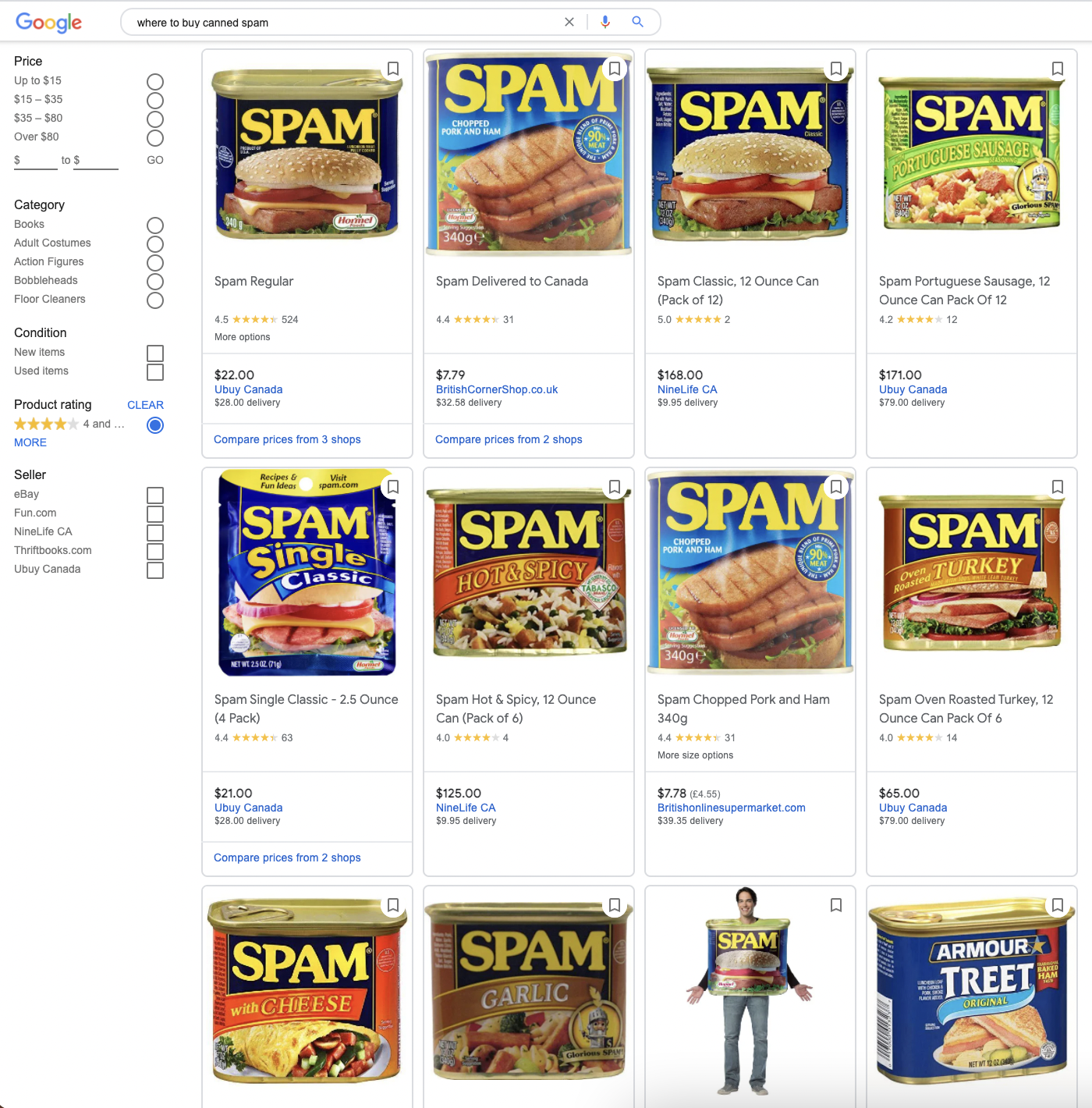
For this query, the Shopping tab brings up Spam varieties sold in different stores and also where you can buy a canned Spam costume—world’s most disgusting costume?
Filter by price, seller, condition (anyone into used cans of Spam?), and product star rating. I clicked the 4-star rating, because I’m only after quality Spam.
Images tab
From the All tab, if Google thinks images will best answer your query, you will see an image pack (more on that under Featured SERP). Clicking on the Images tab, however, will provide a full-screen image experience with filters at the top.
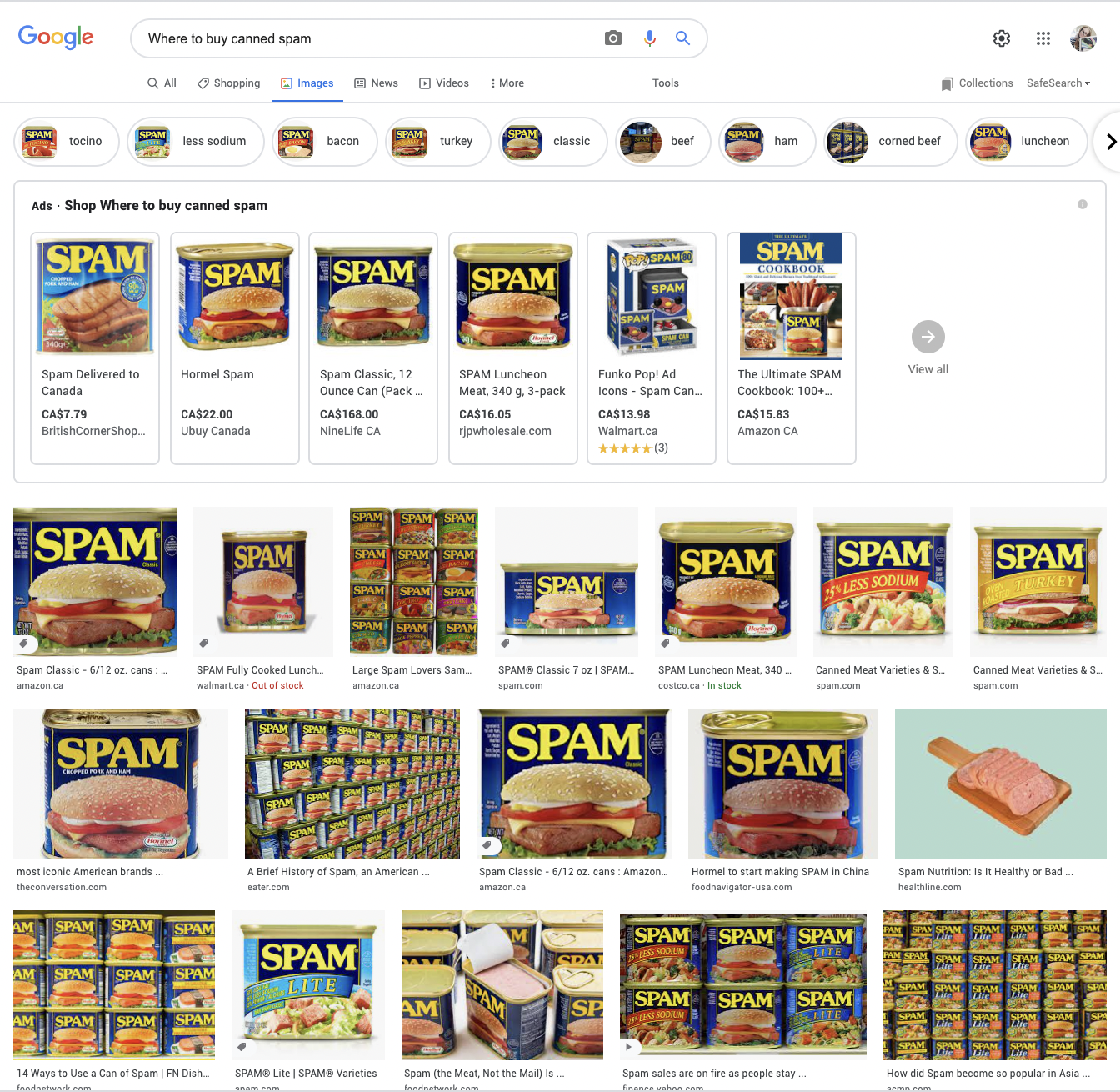
News tab
The News tab brings up recent news about Spam. Two days ago, BuzzFeed featured an article about cheap family meals, one of which was pan-fried Spam covered in mustard and served on Wonder Bread. Mmmmmm 🤢.
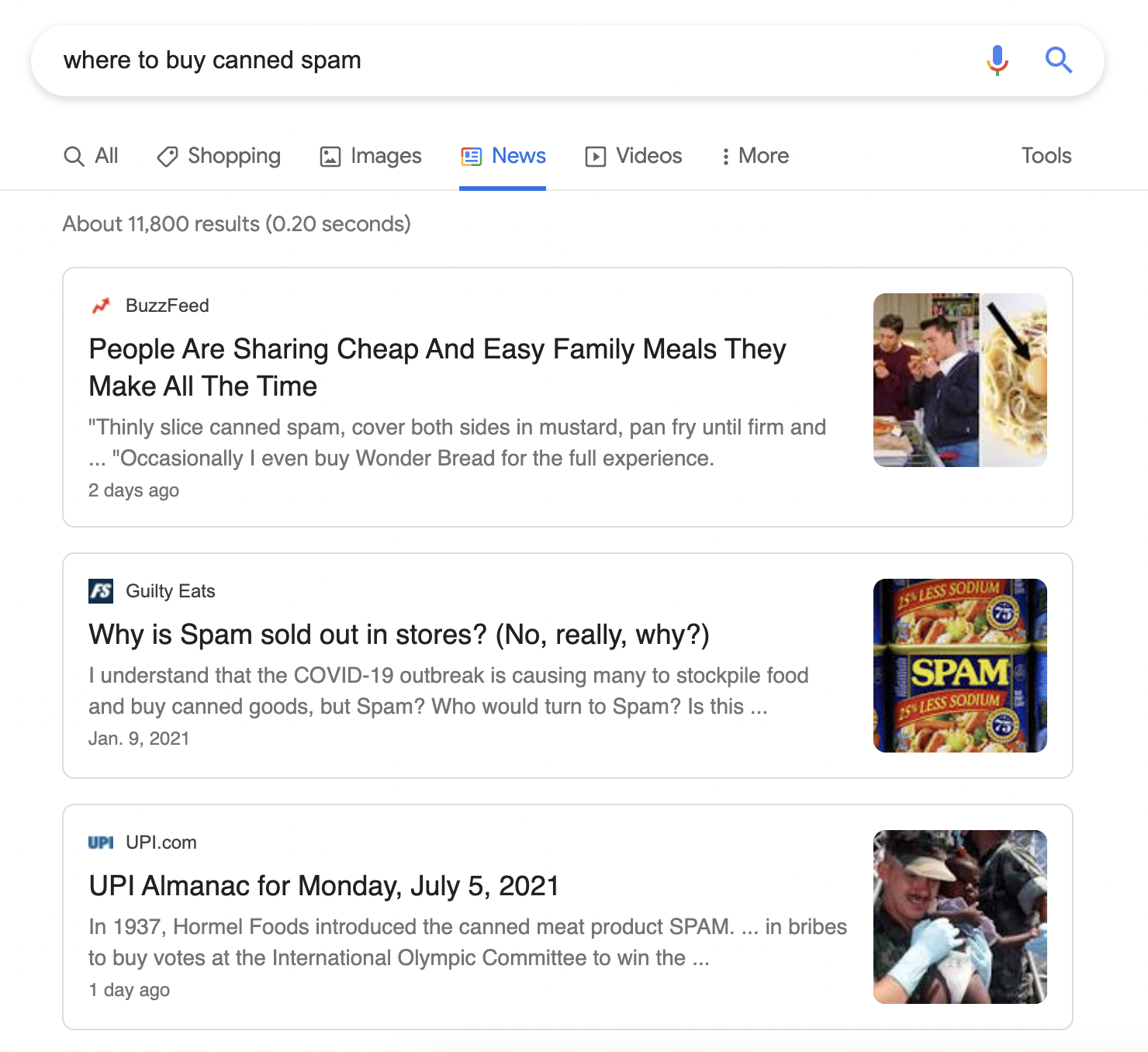
Video tab
The video tab provides search results in…. you guessed it: video format. So if you want to know how Spam is made—**I WOULD NOT WATCH THIS VIDEO**—or what happened to Spam in Hawaii recently, or why you should eat it, the video results tab gives you that information in motion picture.
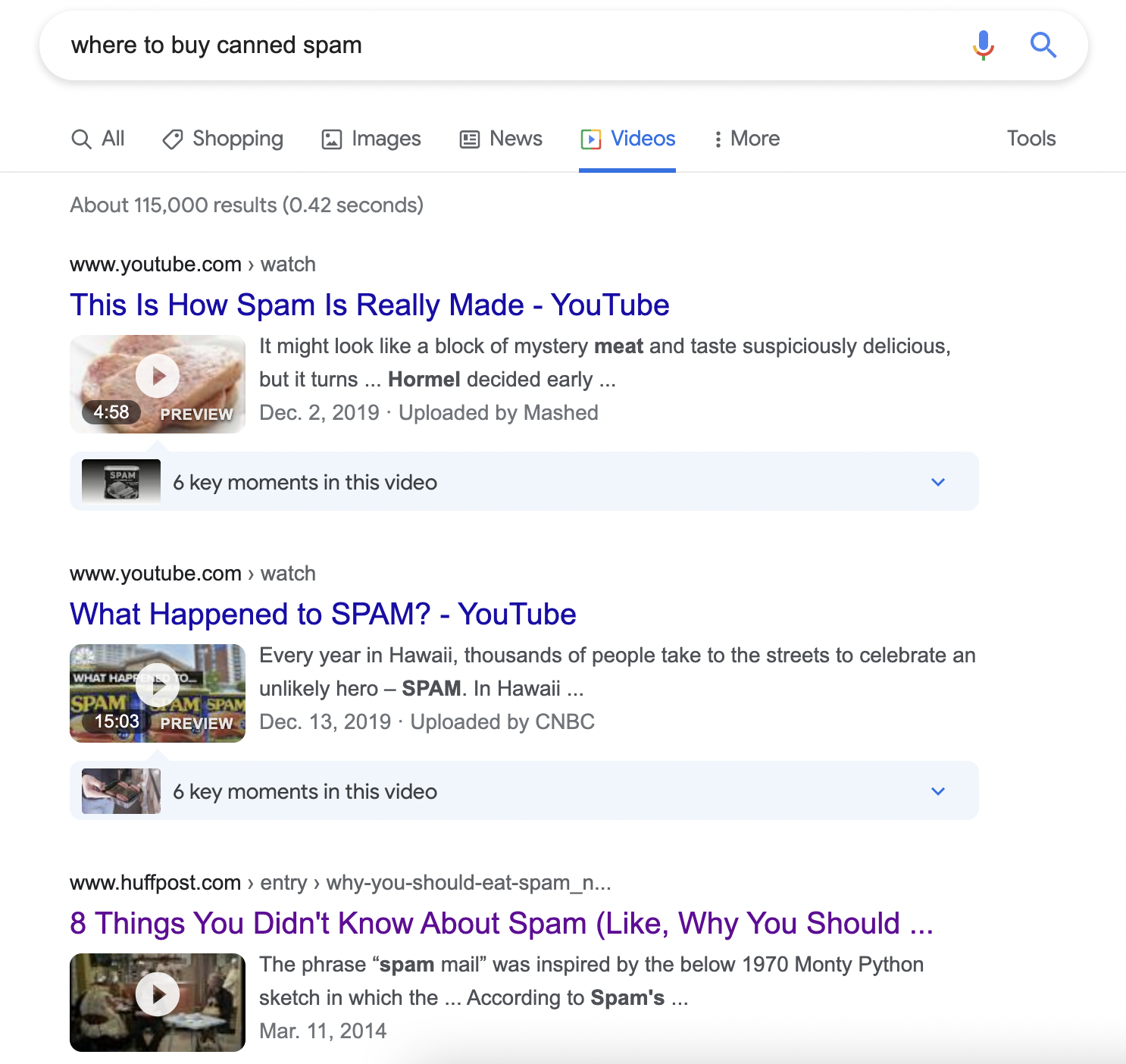
Books tab
For all of the book worms out there, you have a dedicated tab to discover all the books related to Spam.
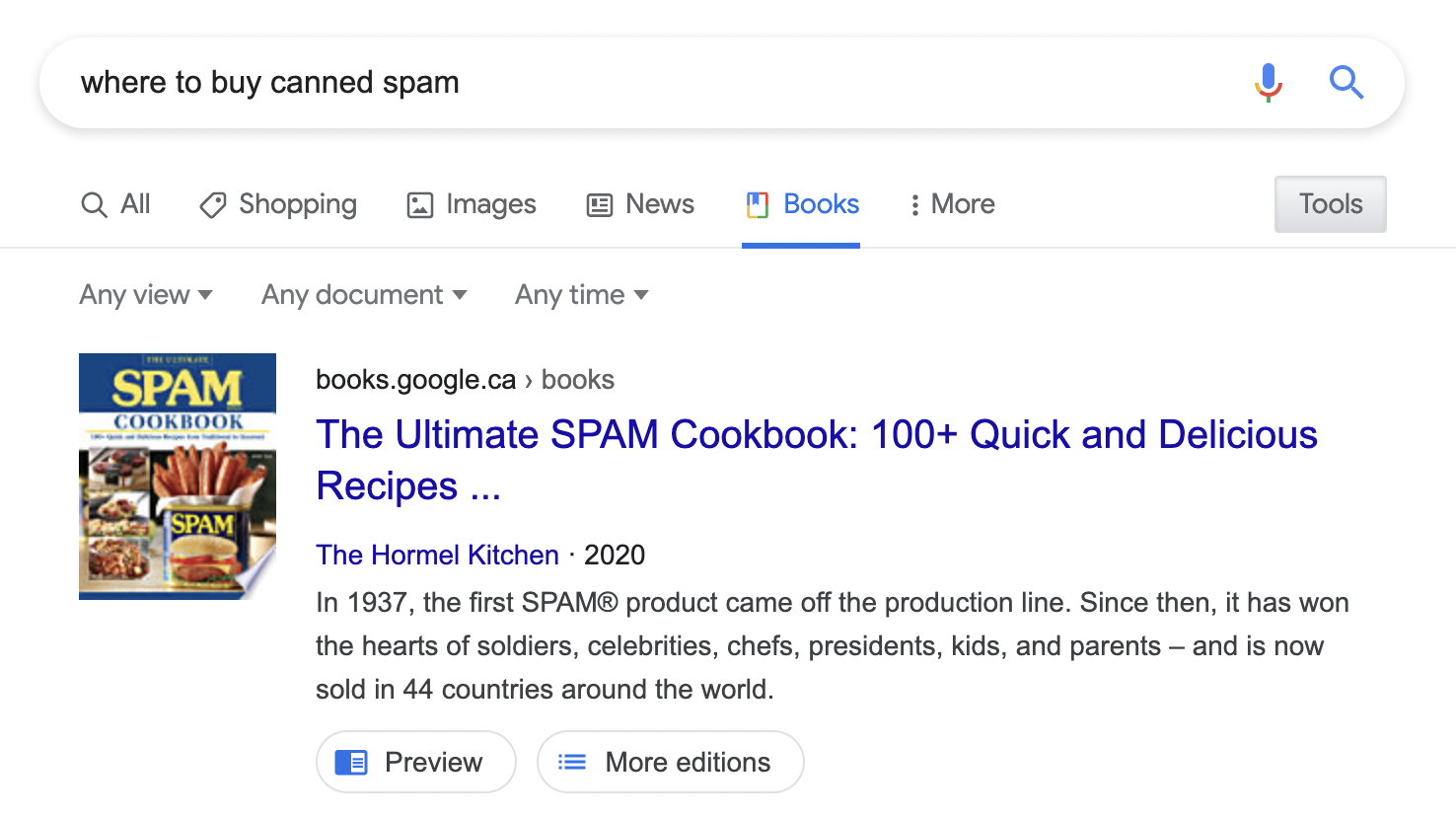
That’s a rundown of all of the tabs but one.
But what’s under the More tab?
More tab
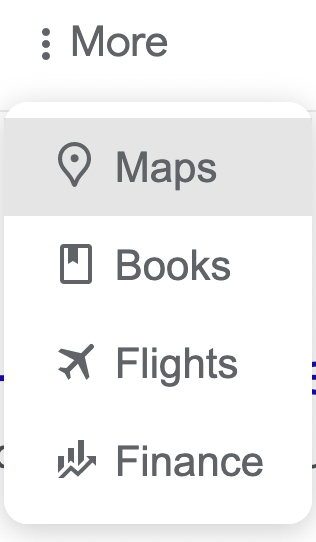
The tab options under the search bar change based on the query. Google displays the five most appropriate tabs, and puts other options under “More.” When looking for where to buy canned spam, the Flights tab doesn’t make the top five search results, so it’s relegated to the More menu.
But if I search for a flight, the Images tab and Video tab get tucked under the More menu.
Maps tab
The Maps tab brings up a map based on the user’s navigational query.
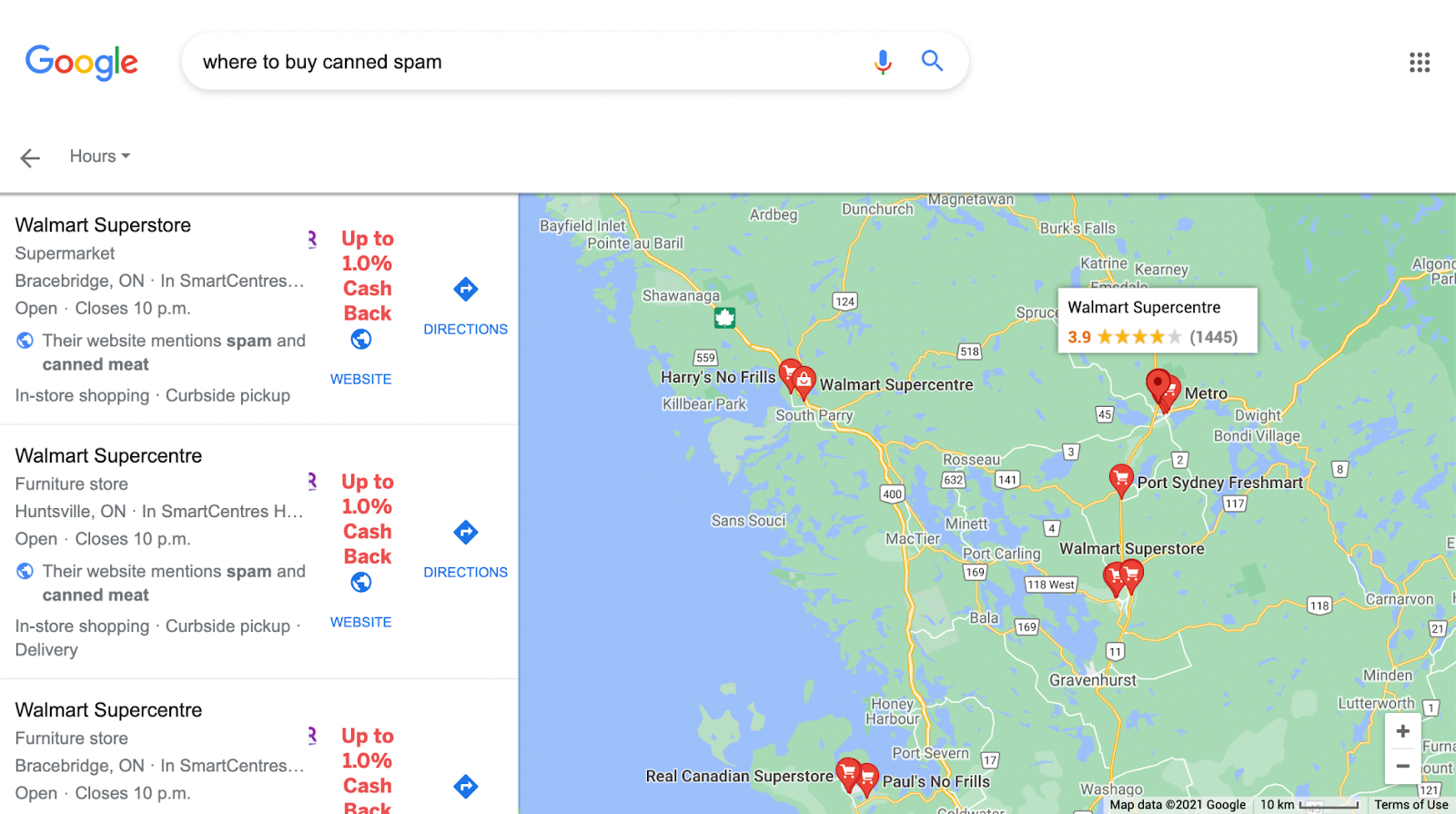
Pinned locations on the map correspond to details about that pin on the left, where the address, hours (if applicable) and directions appear (along with the Rakuten extension, apparently, if you have that installed).
Clicking on one of these pins pops up more details specific to that location, including the star rating (based on Google reviews), services provided at the location (like curbside pickup), address, phone number, the organic search result, Q&As, popular times, an image pack, Google Reviews, and a button to send all of that data to your phone.
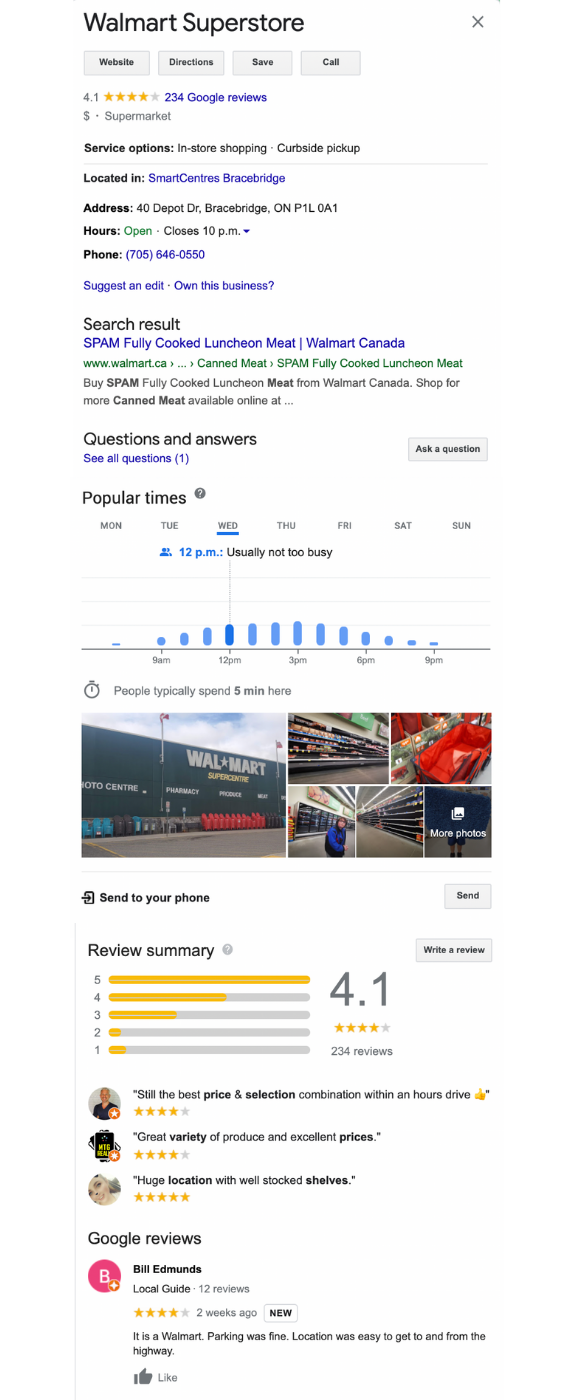
Not too shabby. The Map tab packs a powerful punch.
Flights tab
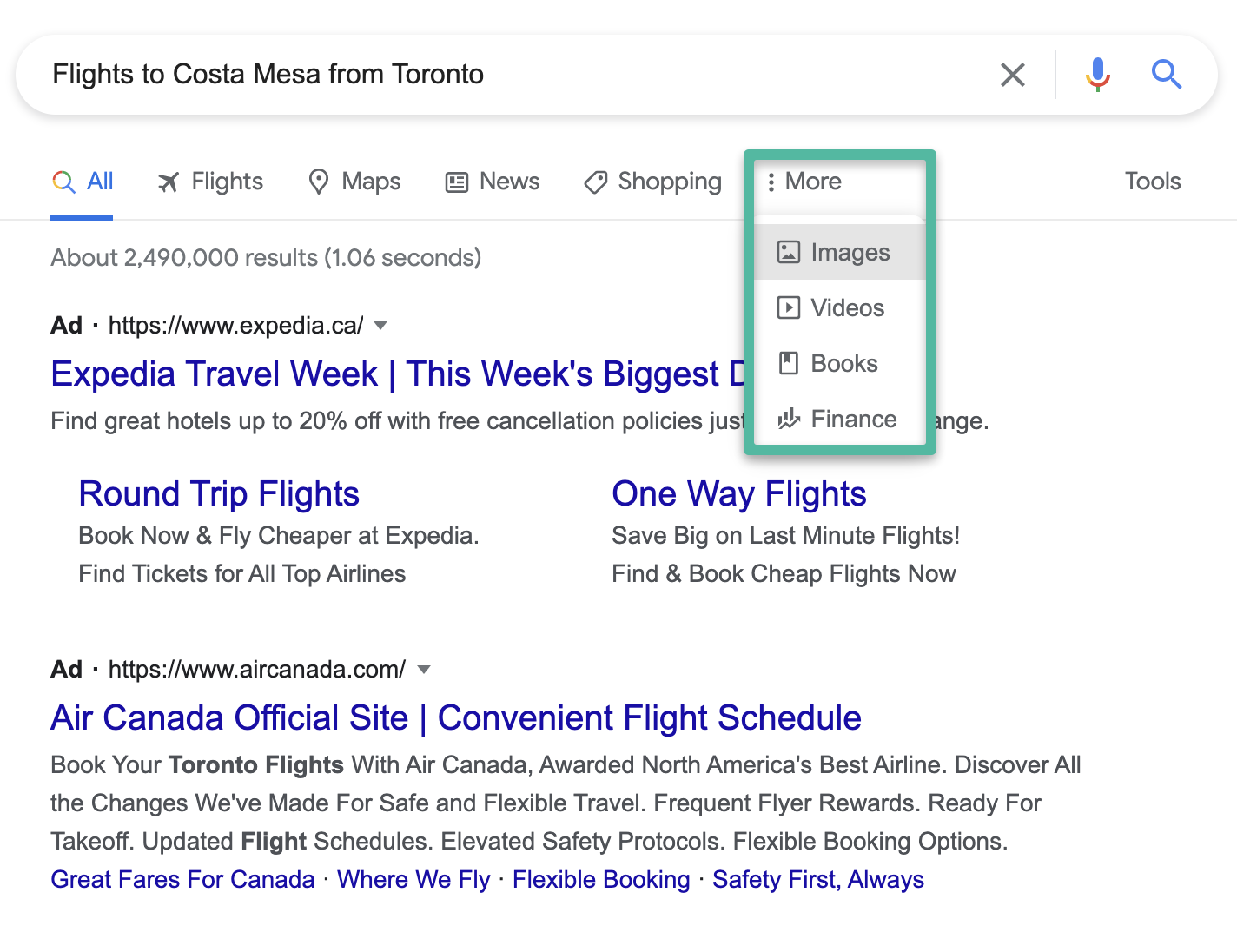
Clicking on the Flights tab brings up a full-page travel experience.
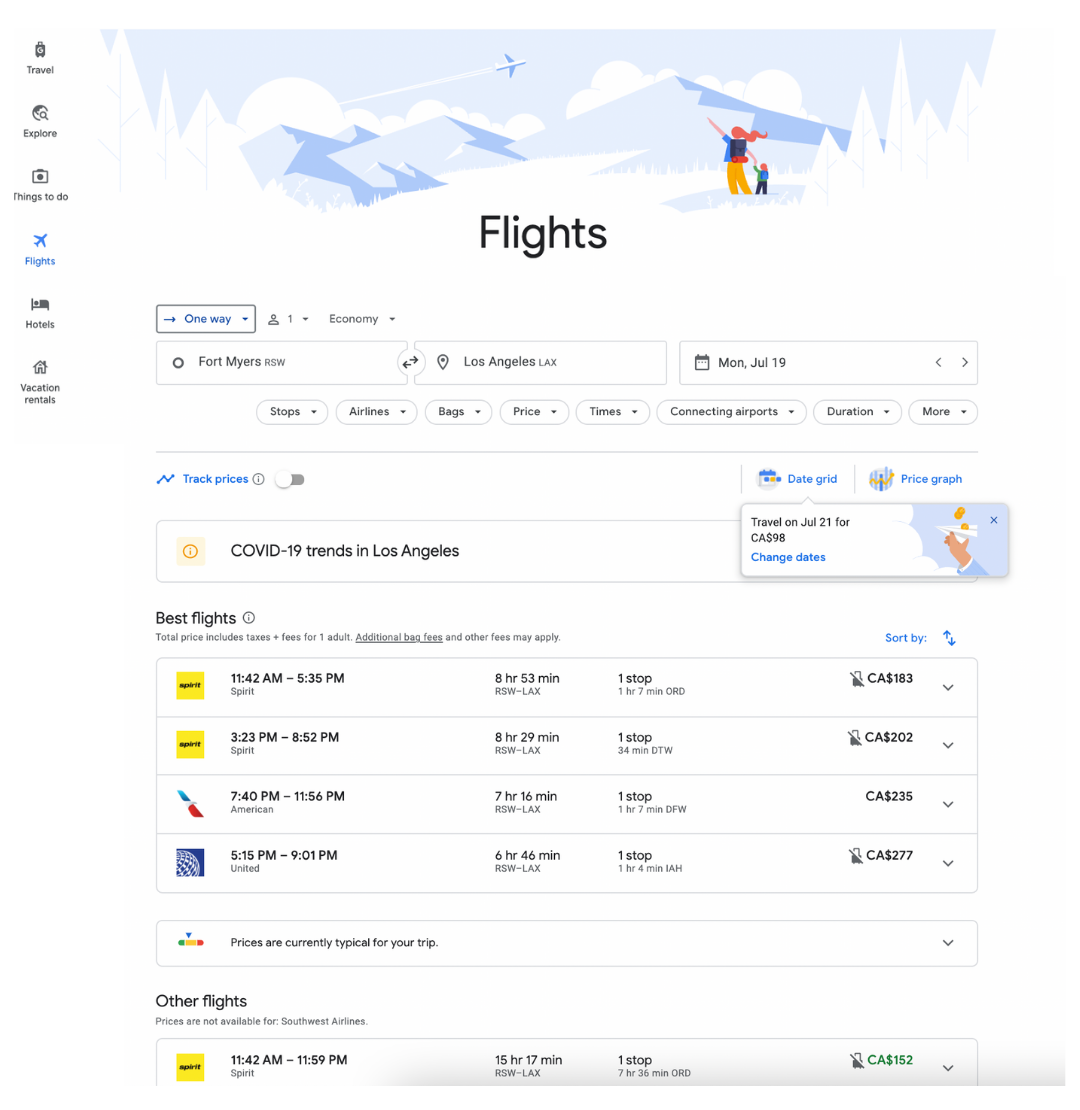
Finance tab
The only time the search type “Finance” makes it into the top five tabs is if you search for something specifically financial in nature. Google Finance fetches current and historical securities information and business news hosted by Google.
Is there a stock for Spam? No. But there is a stock for Spam’s parent company, Hormel Foods Corp.
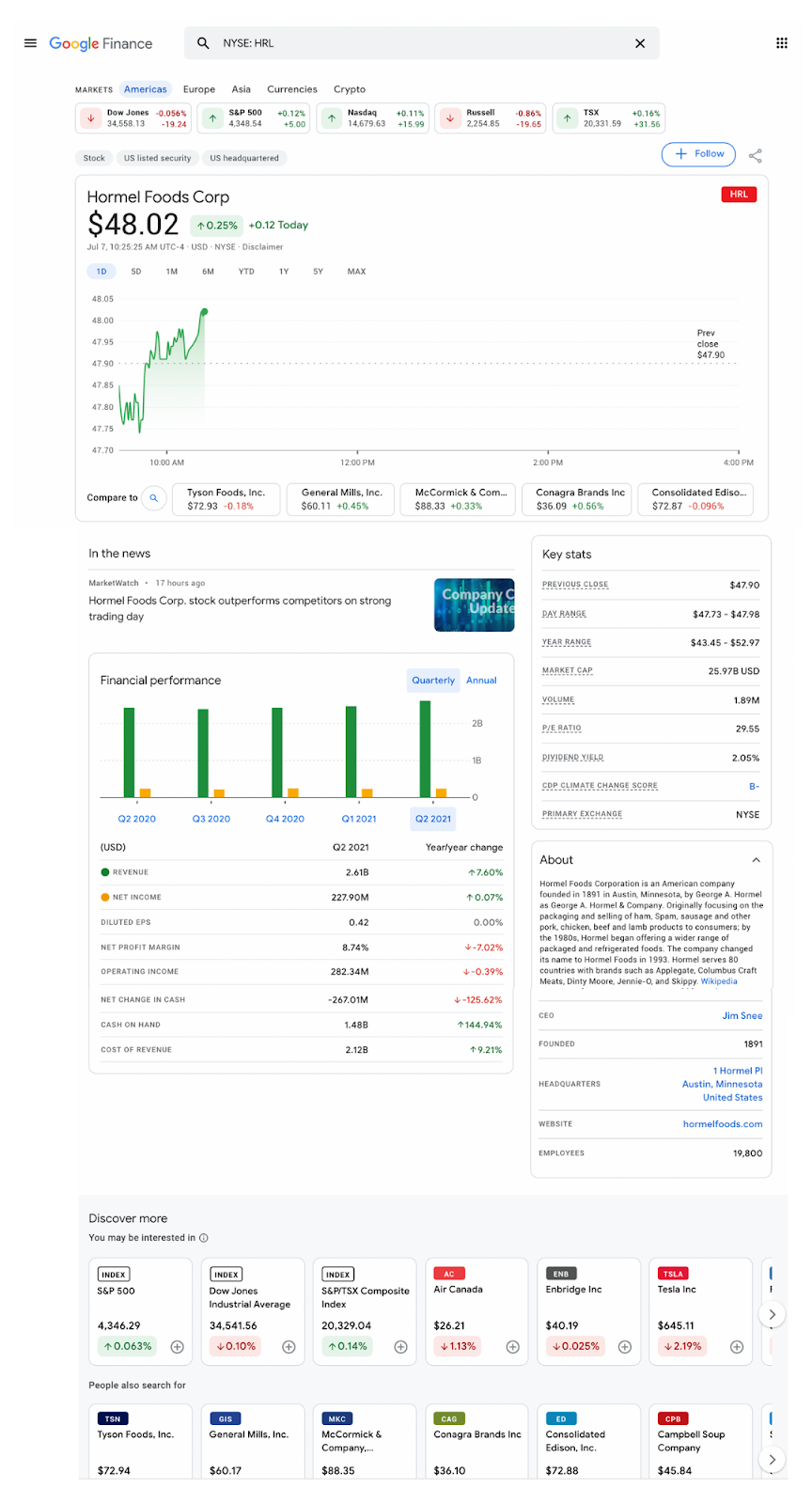
Google Finance also displays a ticker of the stock market at the top, as well as key stats, news, and company background of the stock you’re querying. Discover more stocks and “People also search for” (related stocks) are at the bottom.
And that covers the SERP tabs.
Now let’s look at text ads, since text ads are the first results that appear at the top of the page, under the Shopping ads carousel and above organic search results.
Paid results
Google Ads
Google text ads appear at the top of organic results under Google Shopping ads (if there are any) and at the bottom of organic results above Related searches.
Advertisers create text ads in the Google Ads Editor following best practices for their campaigns so their ads appear in SERP.

Ads appear in what is known as the sponsored section. Paid results are the results you pay for on a per-click basis (PPC). You set up paid ads using the Google Ads Editor. The better you set up your ads, the better the click-through rate (CTR) from searchers and the better your ratings.
SERP Features
Yeehaw. You made it to the fun stuff.
Rich results are added to a SERP page when Google deems them the most useful for users—which makes them the most sought-after for marketers. A SERP feature is any result that’s not a standard organic result or a paid ad. They exist in the special spots.
Here they are:
Answer Boxes
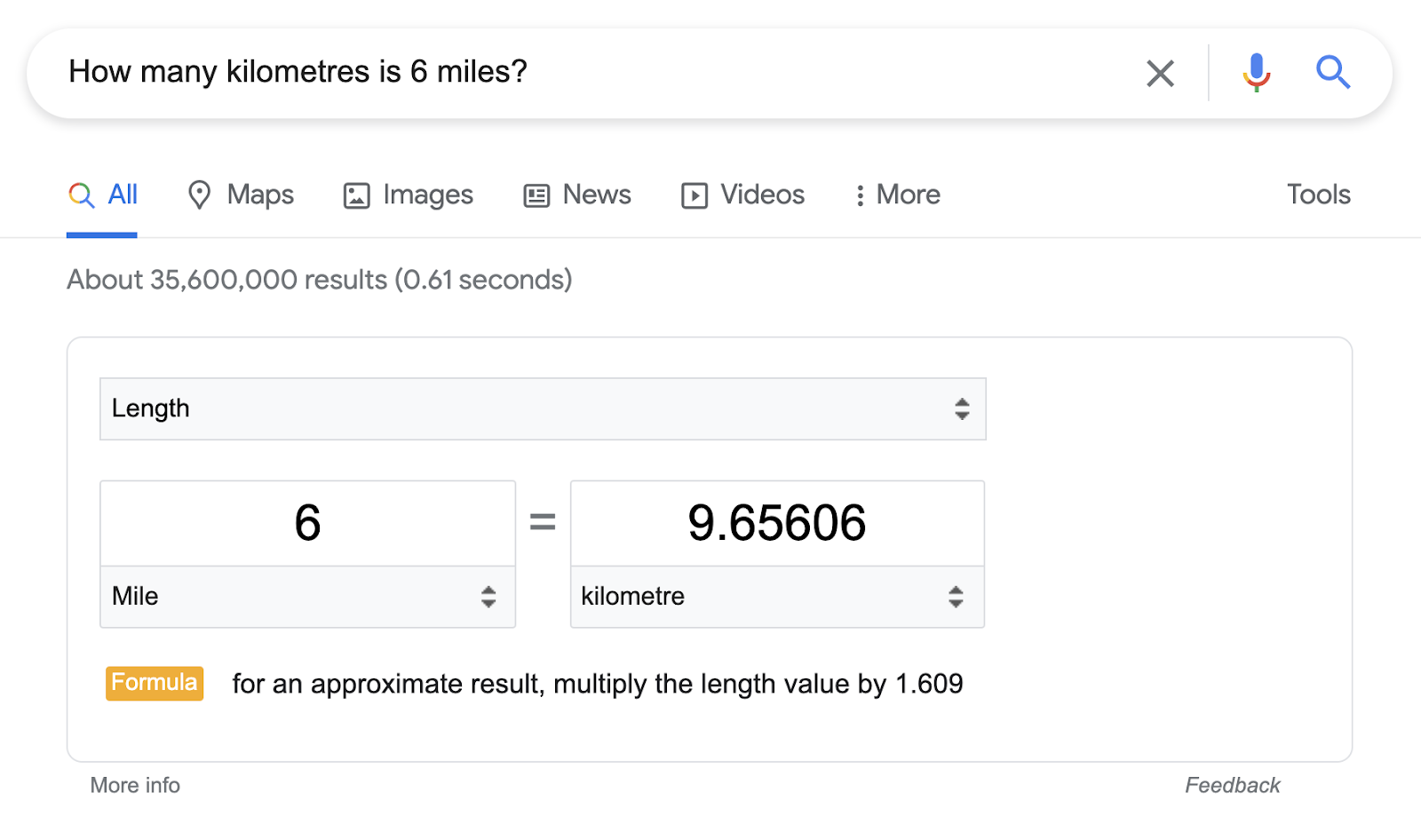
The weather, measurements, conversions, math equations, and even a color picker show up in the Answer Box. An Answer Box directly answers a question that’s unit-based.
How do you get your site to appear as an Answer Box? Rand Fishkin, from Moz, dedicated an entire Whiteboard Friday post to that. It looks like this:
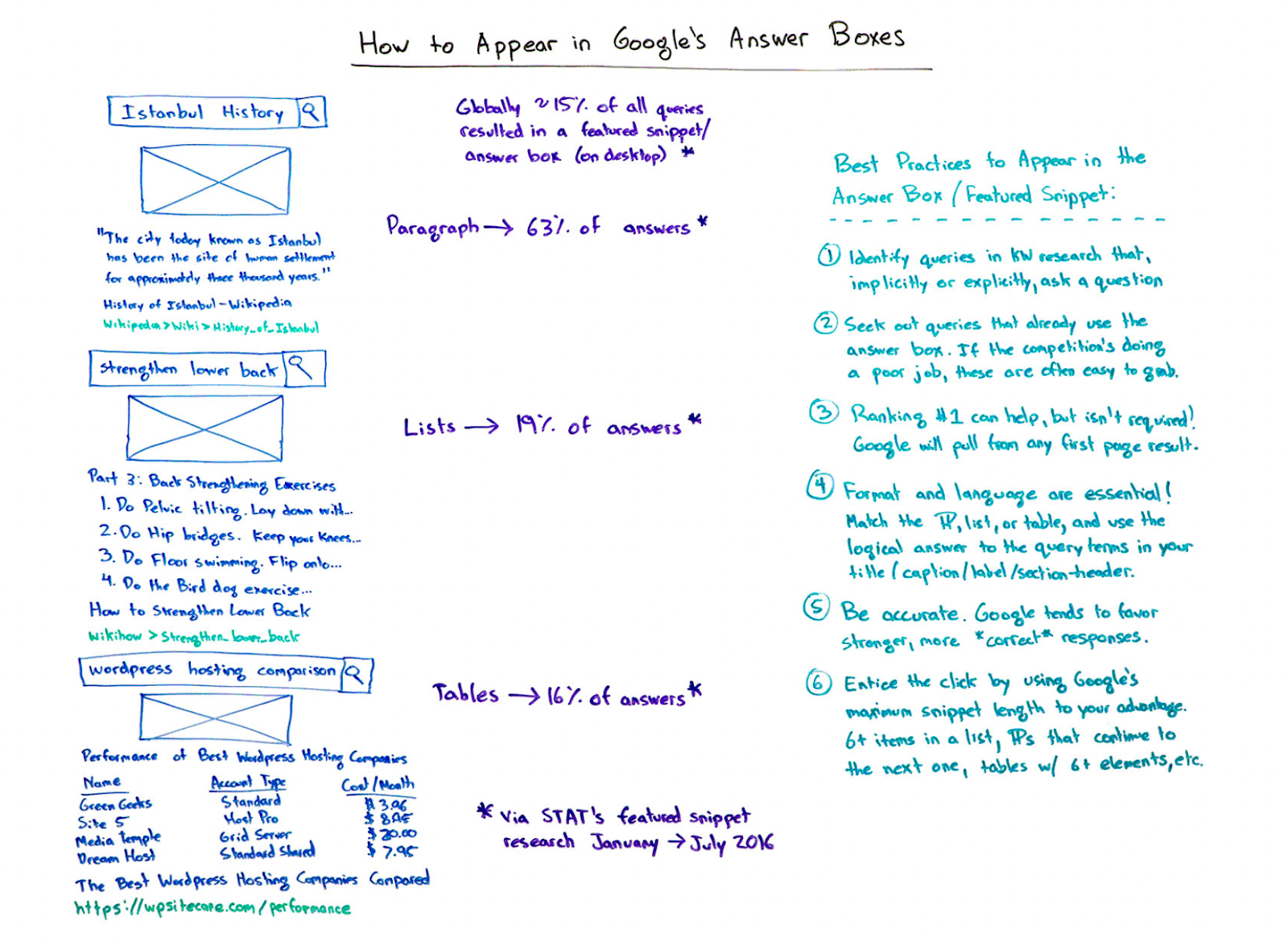
Go to town and Answer Box it up. Is it worth the effort? You’ll have to read the post.
Featured Snippets
Also called rich snippets, and rich results, featured snippets get special attention. Winning one is something to dance over.
If Google decides that your snippet (which is your title + meta description + keyword + URL) exactly matches the user’s search intent and has the best chance of answering the search term query (with the snippet alone or by clicking through to your site), your snippet is highlighted on the SERP page.
Let’s get away from canned meat for a minute.
How about we search up the adorable quokka, a marsupial that lives on an island off the west coast of Australia to highlight featured snippets.
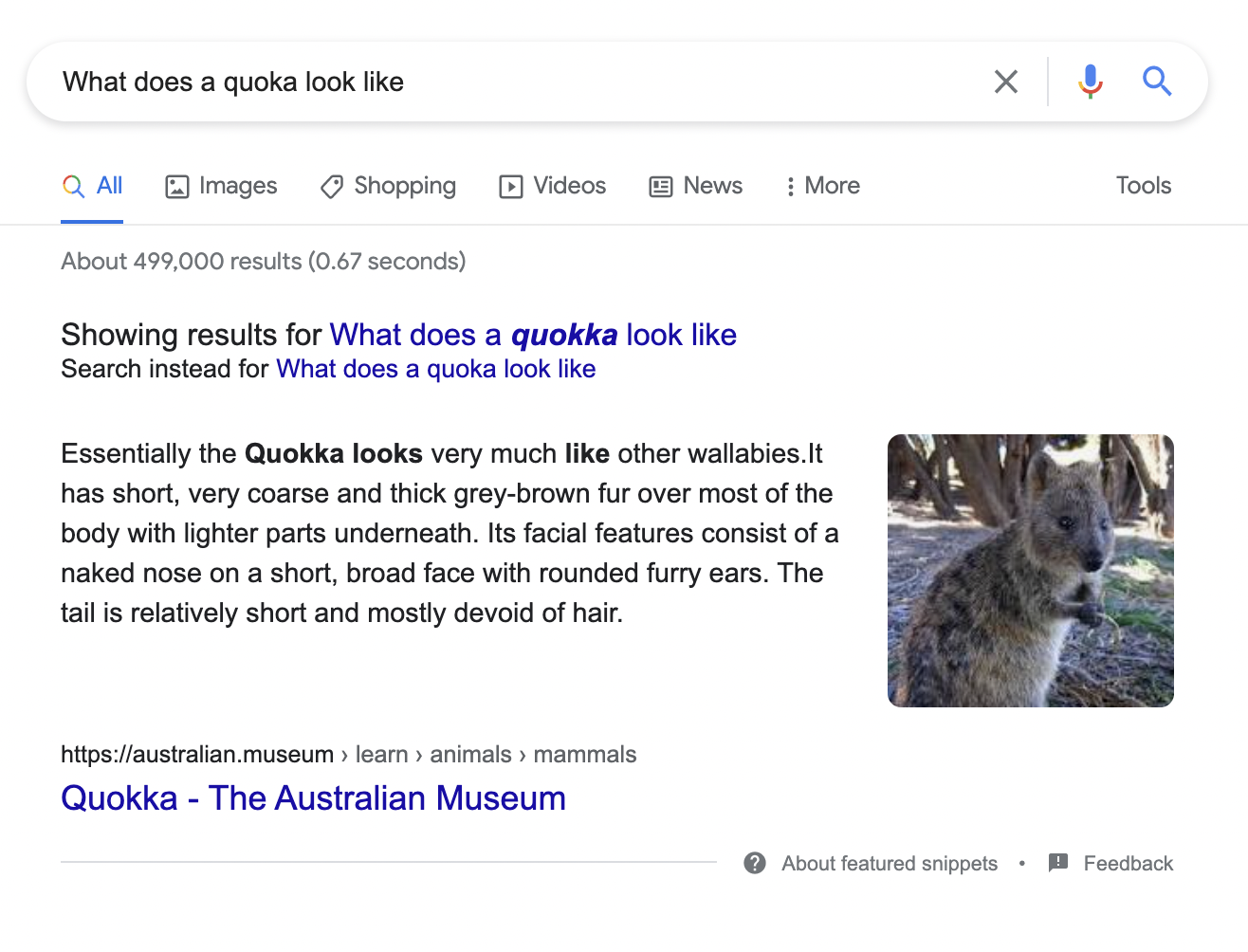
The Australian Museum won this featured snippet because it answers my question fully. I don’t even need to click through for more information. Google also knew I spelled quokka wrong, and displayed results for the correctly-spelled marsupial.
It’s Google’s way of saying, “Great job answering that query.”
Featured snippets appear at the top of search results, within the "People also ask" section, or next to the Knowledge Graph information.
Featured snippets stand out on mobile and voice search.
I’m going to take a quick minute to point out that Feedback link at the bottom of the featured snippet example above.
Feedback
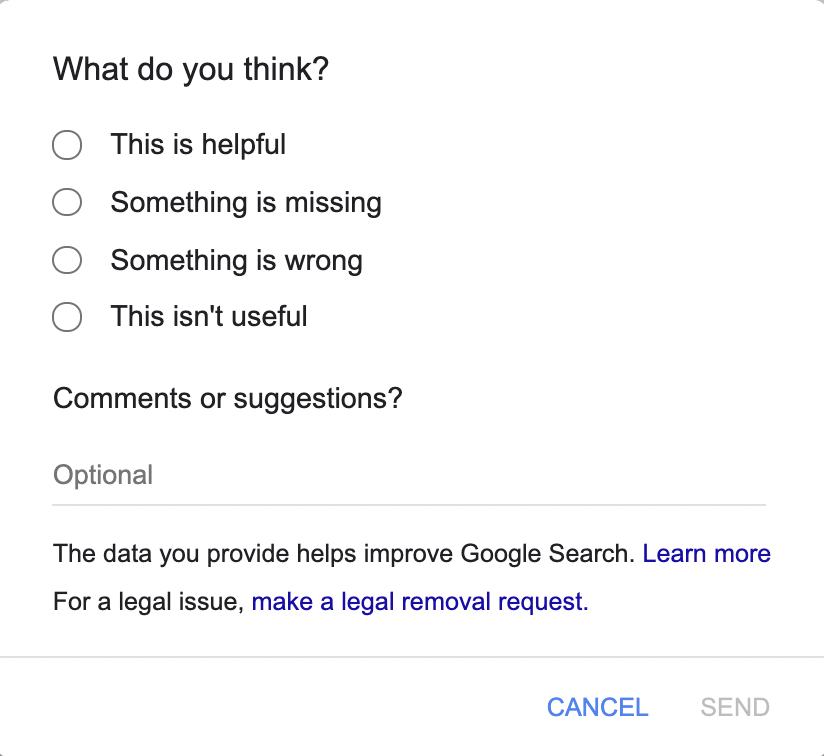
Google actually cares about showing searchers the best possible search result. At the bottom of each SERP feature box, there is a feedback link where anyone can let Google know if the featured data was excellent or crappy.
Mad respect, Google.
Image packs
Image packs are search results that appear as a grid of image thumbnails that link to external pages.
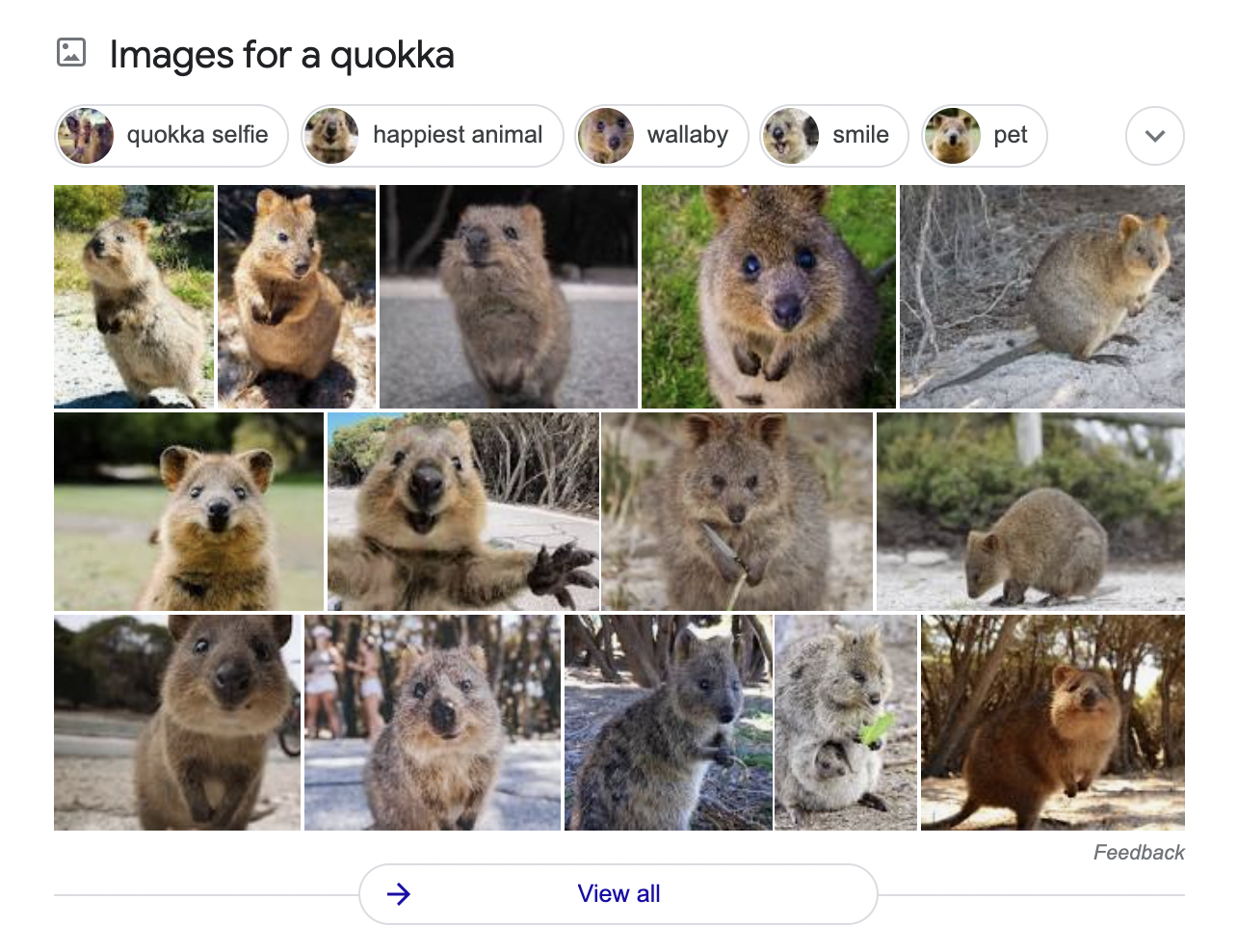
I want to click on all of the thumbnails in this adorable image pack. If you click View all at the bottom, you jump to the Google image tab where hundreds of pictures of the world’s happiest animal greet you.
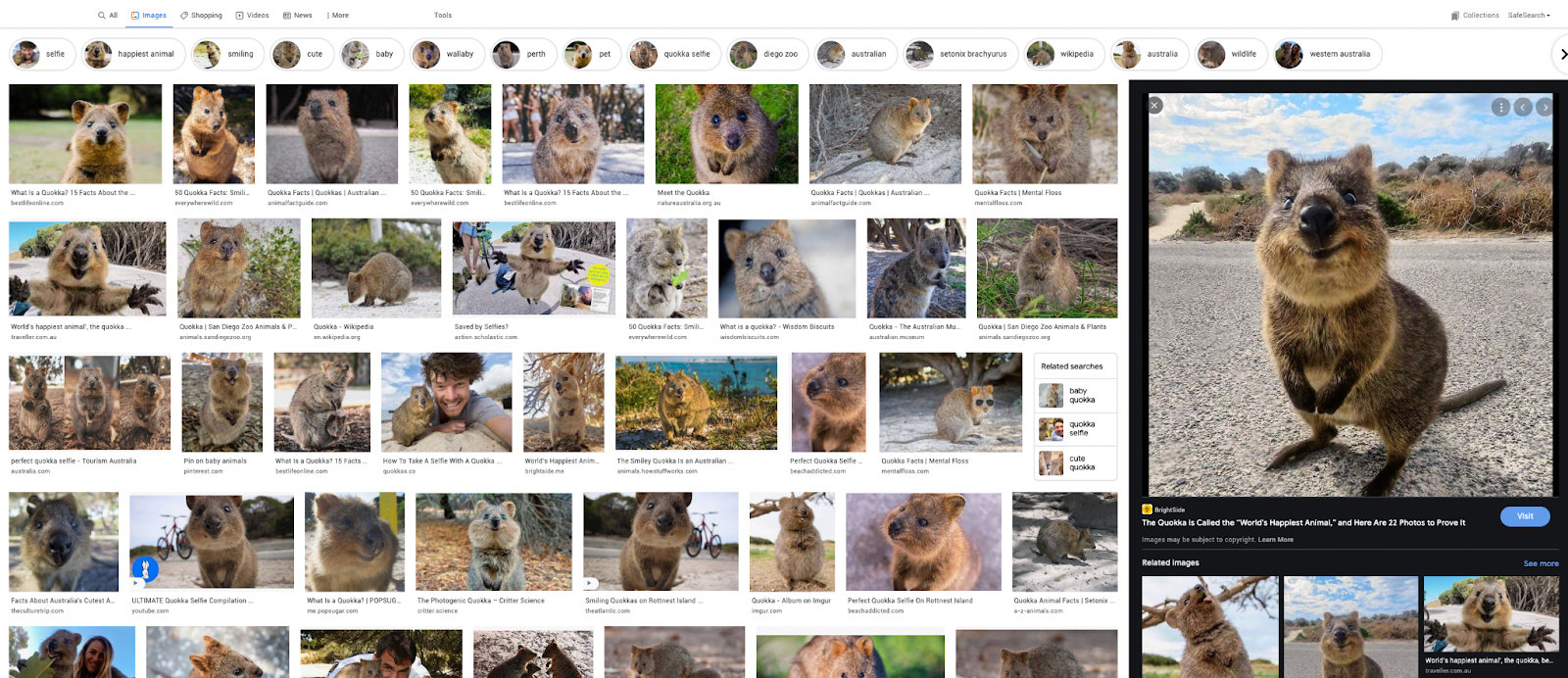
Image packs may appear in any organic position. From both the image pack and the Images tab, if you click through to the image tab, you have quite a few sort options.

The sort options change based on the search term, too. For things like logos, you can choose between transparency, white background etc.
People also ask
This rich feature lists some of the results that you see in Google Autocomplete (the dropdown menu of suggestions that appear as you type your query). People also ask generally appears in the middle of organic search results.
Back to canned meat.
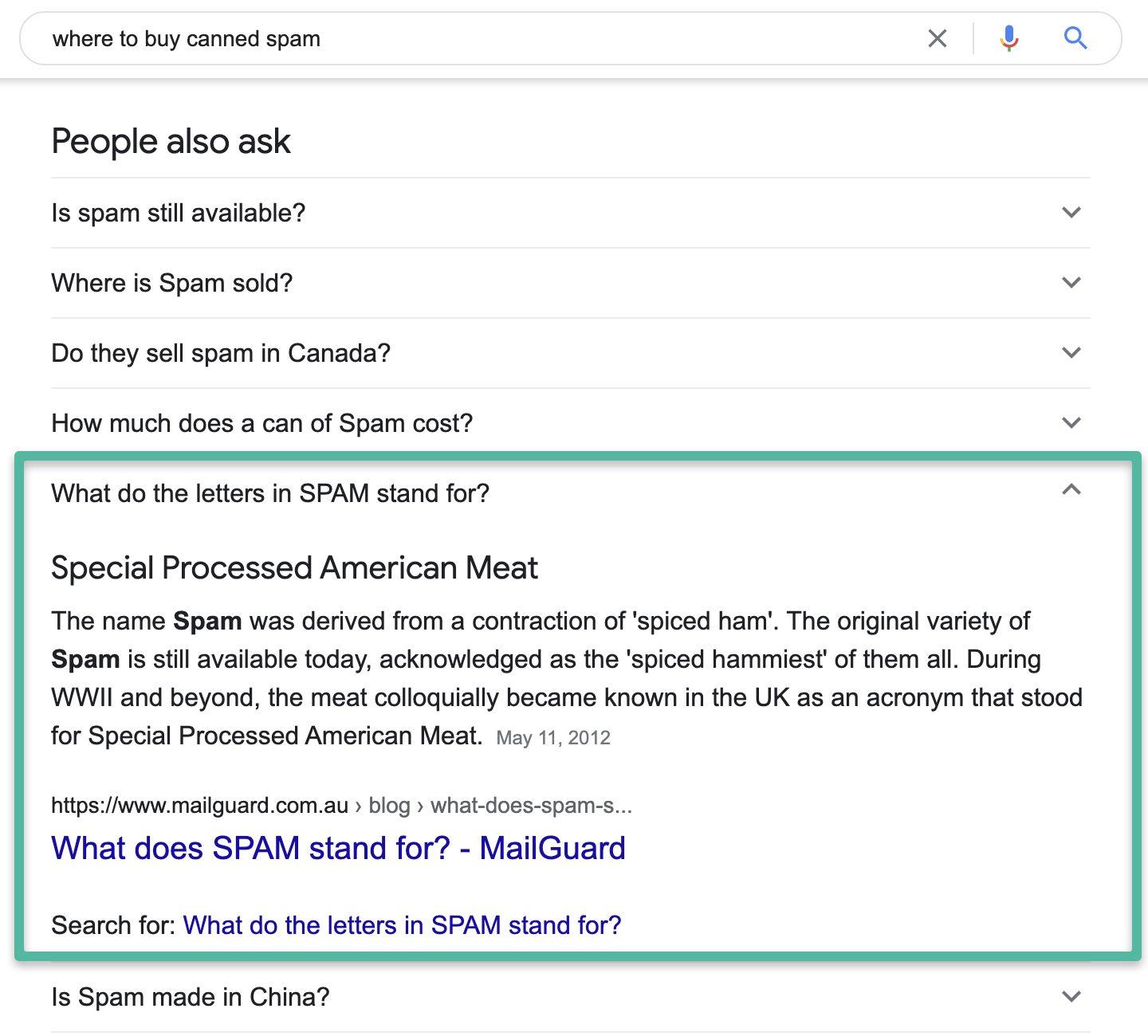
According to Ahrefs, you’ll see People also ask boxes appear on a SERP page about half the time.
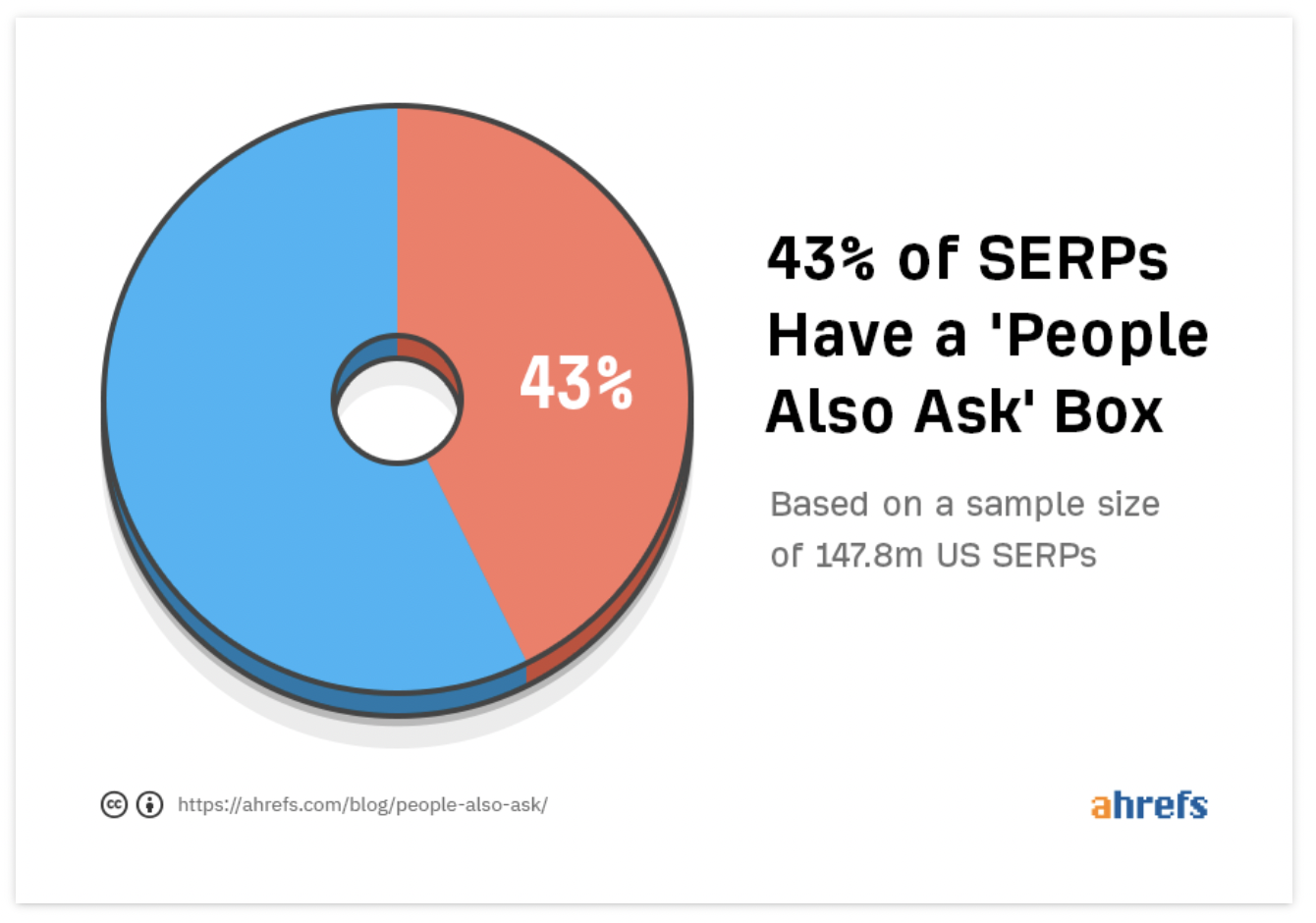
Related questions
How is People also ask different from Related questions? Good question. I wondered that myself.
There’s a big difference.
People also ask comes directly from the database of queries people have entered into the search bar related to that topic.
Related Questions, on the other hand, shows algorithm-generated results that Google thinks is semantically related to your search query. Related questions tend to appear at the bottom of SERP.
Knowledge Panel
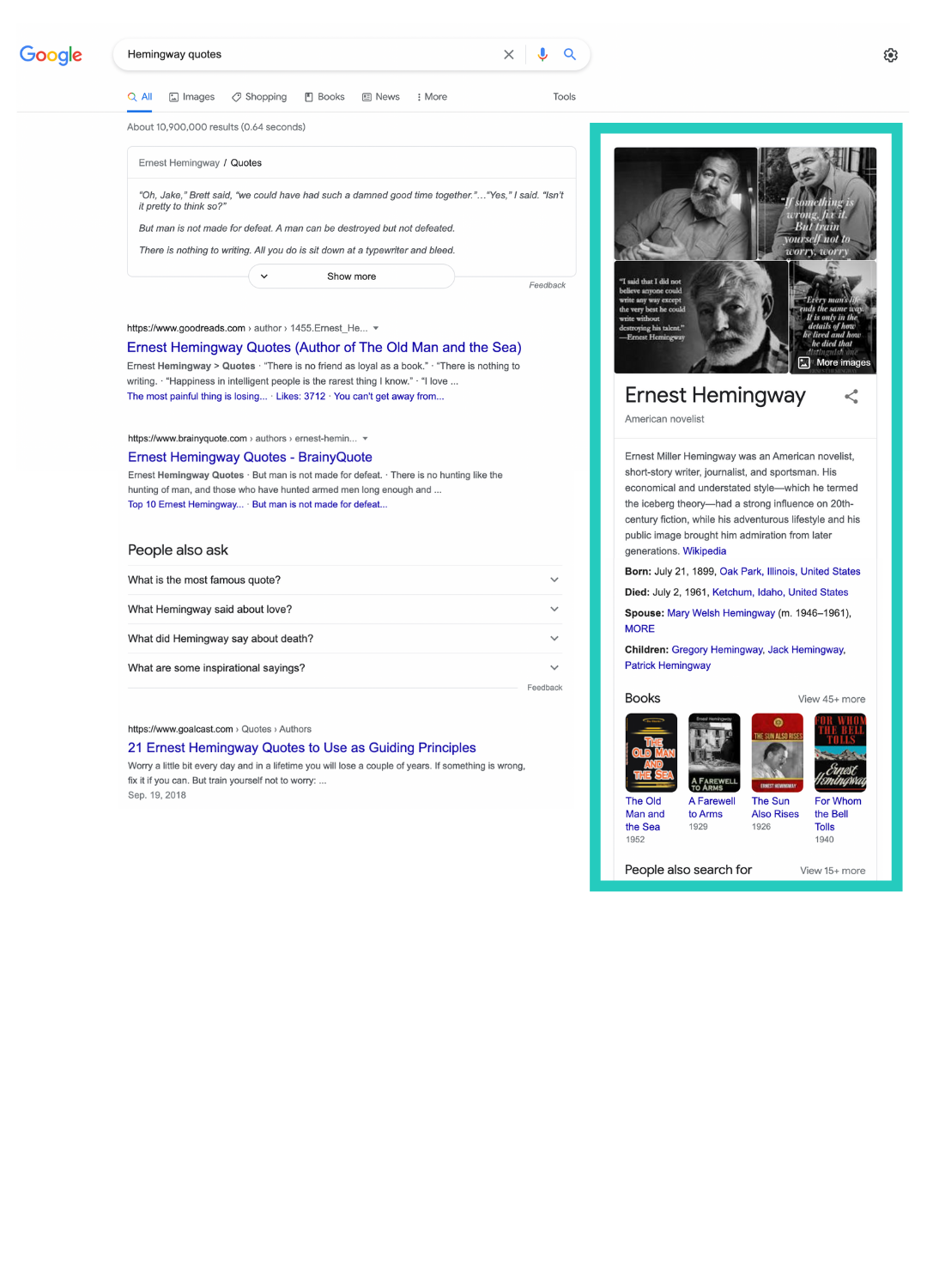
Also known as Knowledge Graphs and Knowledge Cards, this SERP feature pulls data from different sources (including Wikipedia and the Google index) to provide viewers with a concise snapshot of information.
Local Pack
When a query includes local intent (a service or restaurant in your area, for example), or includes “near me,” or “nearby,” Google will show results close to your geographical location.
The Local Pack includes a map with pinned locations and a 1 to 5-star rating for each location. It will also show organic results and paid results.
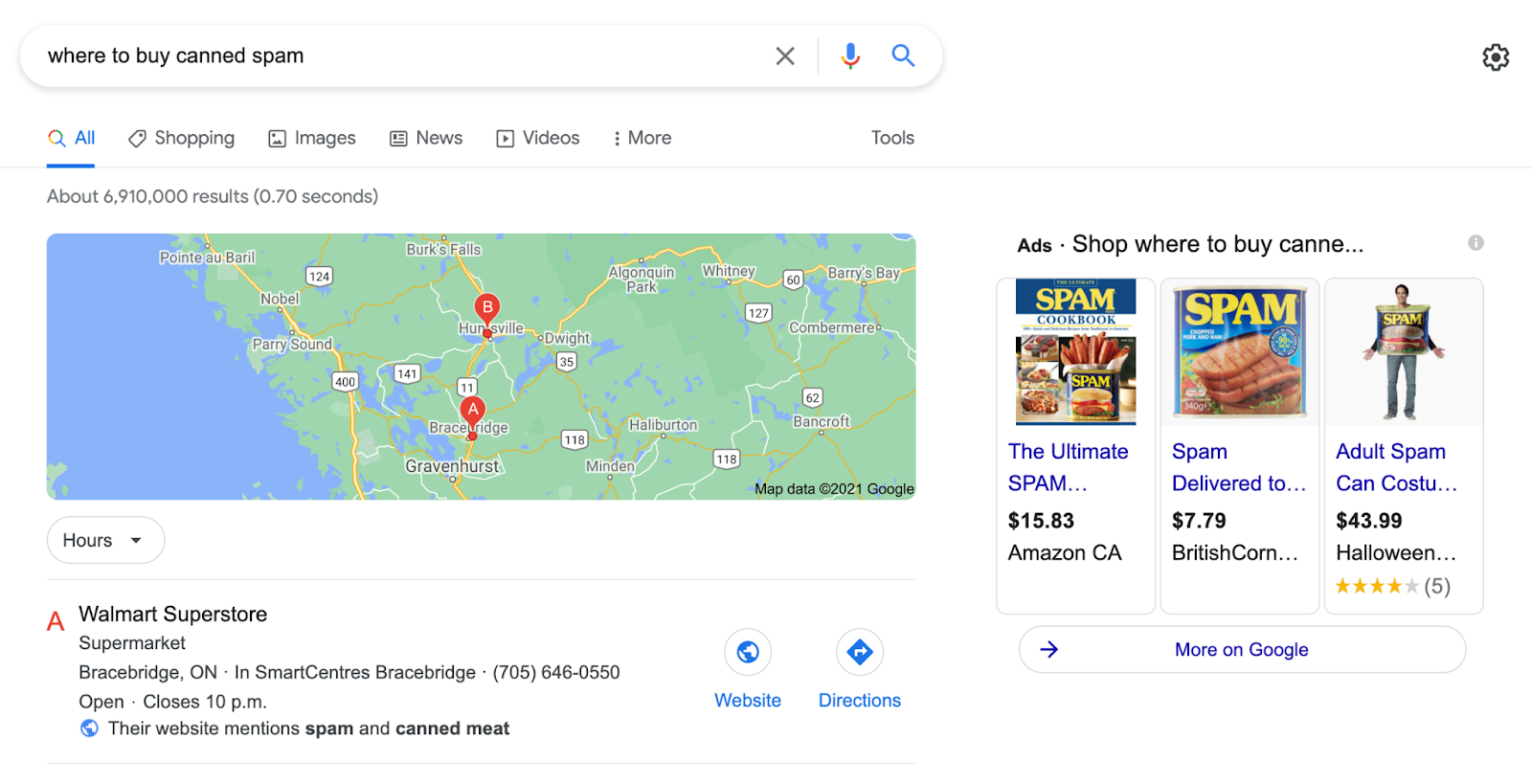
Clicking on a Local Pack will jump to the Map tab with a longer list of pinned locations to explore.
That’s an overview of the rich features you’ll find on a SERP page. The last part of a SERP page is also the one where you are most likely to appear.
Organic search results
Organic listings are where your site shows up according to the user's search query (based on your high-quality SEO work). Your goal is to appear at the top of the SERP, ideally in the first 1-3 spots. Even more ideally, as a featured snippet.
Why is page one so important?
Because 5 billion people perform over 6 billion Google searches every day (and almost as many YouTube video searches) to find information that exists on over 2 billion websites.
A basic search query for the adorable quokka:

Chances are, Google will pull up an image pack based on this query. Chances are also good that Google will know I meant “quokka” with two Ks.


On this SERP page, there are only three organic results. One is sandwiched between the image pack and People also ask. The other two appear between People also ask and Related searches.
Scroll too fast, and you’ll miss them. But do look for them because they were valuable enough to compete with the rich results and the paid results to appear on this page.
They earned their spot because of sensational SEO and careful CRO.
Site Links
Site Links work like a sort of rich feature within organic listings. Typically found when you search for a company or specific domain, Google will break out sub pages (site links) under the snippet so you can get a sneak preview of what content exists on different pages.
Schema markup helps you win a site link breakout.
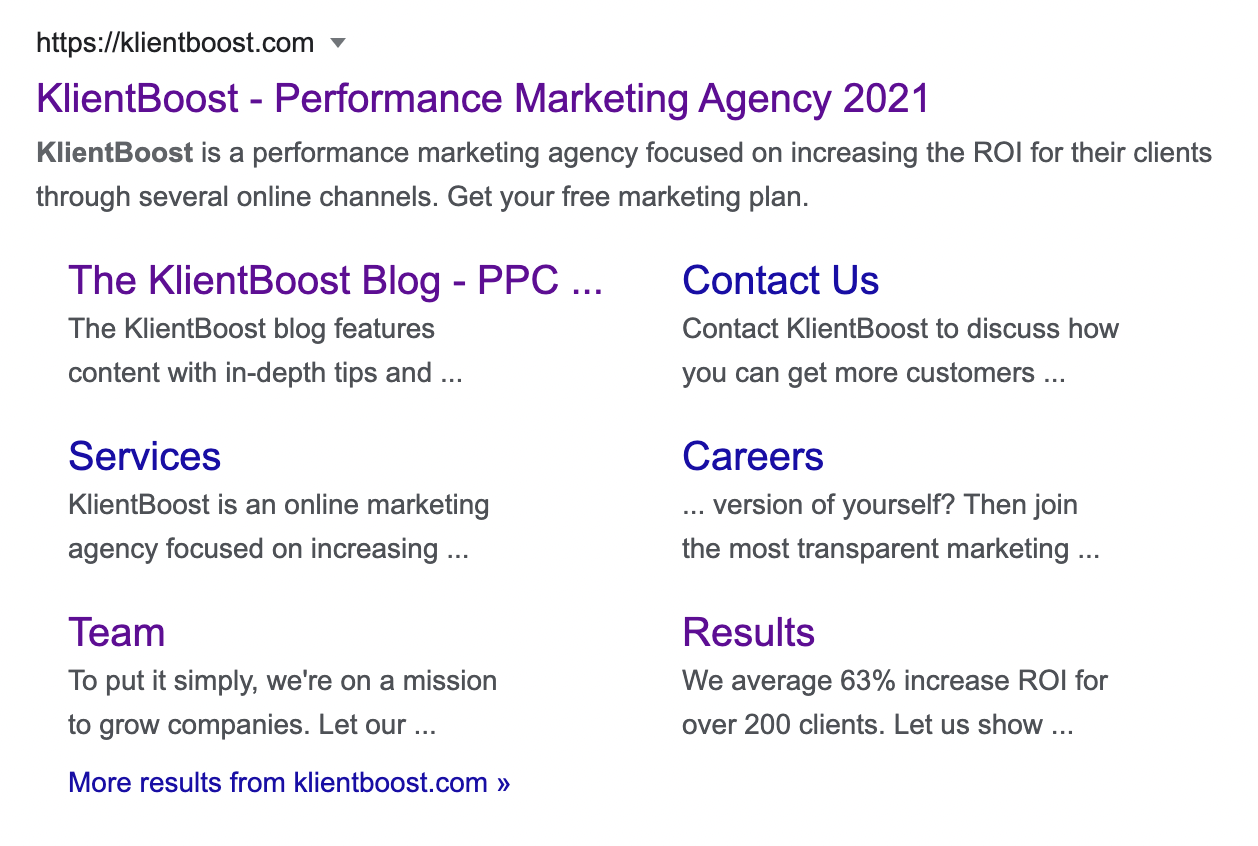
Search engine optimization (SEO)
There is a strategy behind landing on the first page of SERP (which is the only page that matters).
You optimize your web pages for search engines using SEO tactics. There are specific things you do to get on the first page of Google SERP. Each of these tactics tell Google that your page is worth showcasing as an organic search result (or featured result if you’re lucky), hopefully on page one.
SEO tactics include:
Keyword research
Do your keyword research. This is a fundamental, core must-do for SEO that will make sure you’re writing about the right content in a way that people are searching. If you get this wrong, you’re in a spot of bother (you won’t land on page one).
To make this part easy, use keyword research tools.
Meta descriptions
Once you have your keyword shortlist, build content around them. For each page or post you make for your keywords, create a killer meta description. It’s the one or two sentences that’ll show on SERP below your page title. The better the description, the more clicks you get. We have a master meta description guide to walk you through that.
Links (anchor links, internal links, external links, and backlinks)
Google ranks the value of your page based on the content itself—the keywords, design, and user experience (UX). But Google also takes into account how associated that content is to information on the same page (anchor links), content on your other pages (internal links), high-domain authority (DA) pages across the internet (external links), and how many high DA pages link back to you (backlinks).
Alt tags
Label your images with your keyword. These image labels are called alt tags. Google reads images the same way it reads words. If you don’t describe your images, you’re losing out on a lot of rank value.
Schema markup
Schema does the talking when it comes to search engines. Also called “structured data,” schema markup is code placed on your website to give search engines the down low on what your page is all about.
There are 11 common types of schema markup that you can do to tap dance in front of Google when it comes to your SEO. To make schema easier for WordPress sites, you can use a plugin.
And that’s how you up your chances of winning an organic listing on the first page of SERP for your targeted keyword.
And now a word on how amazing/frustrating Google’s changing algorithm can be.
Google's algorithm
Over 200 search engine ranking factors feed into Google's algorithm. It is a complex, always-evolving system that sorts through hundreds of billions of webpages every day.
Its sole purpose is to help people around the world find the most relevant content that answers their queries in a fraction of a second—and then displays those relevant answers in the best, most useful context.
And it’s not one algorithm. It’s a series of algorithms.
Frequent updates are frustrating for marketers because, when the rules change, rank position usually changes—sometimes in a negative way.
But accuracy requires this sort of evolution.
What kind of marketers would we be if we didn’t embrace change and figure out how to solve our rank problems?
As my man, Einstein, once said: Life is like riding a bicycle. To keep your balance, you must keep moving.
So find your balance on the search engine results page, friends, and appreciate that we are always moving toward something better.
If you’re ready to get your content onto SERP, check out our guide to SEO and if you’re really feeling up to it, perform an SEO Audit to boost your current rankings even higher.

